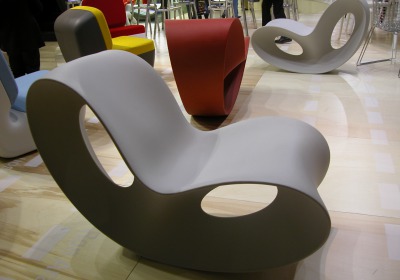Show Review: Milan Furniture Fair 2006
Fri, 21 Apr 2006Located in one of Europe's most fashionable cities, the Italian design fair is in its 45th year, newly housed in 'Fieramilano' west of the city centre. That the venue effectively disperses crowds knotted on the underground says something about its size and the somewhat compromised transport infrastructure that has to handle the 200,000 show-goers that come in from across the world.
Beneath architect Massimiliano Fuksas' sprawling structure nestle 24 considerable arenas, FTK Salon Satellite to the side. Satellite is one of the main draws of the whole fair, where colleges and recent graduates display their work: this is often the most thought-provoking part of the show.
I can add some text
Lahti University, Finland and University of Falmouth, UK were two of the many institutes exhibiting, and there was the usual popularity with German designers as well.
Work was not just restricted to Europe, however: one of the most striking displays in Satellite was by New Zealander Georgio Saltos, presenting two innovative chairs that also caught the eye of Audi and Nike. One of them, 'The Illegitimate Son of Mars', uses two cast aluminium pieces welded together, with the separating gap reducing any flatness. While the construction is interesting, however, it is the splayed form that instantly grabs one's attention, and is hopefully one that, with the necessary backing, will enable Saltos to bring it to production.
The sheer diversity of this year's chairs impressively displays how many solutions there can be to one problem, other eye-catching designs including extensive use of dissected Barbie dolls and a sofa assembled from many smaller foam blocks. Presented by Hidden Art, the greyscale tone of the latter is offset by yellow, whose modules upon closer inspection reveal themselves to all be formed as miniature chairs.
This colour scheme was repeated elsewhere, particularly at Viable. Here, yellow pieces again were used as accents to a dark background, giving a commendably resolved room, something not always found in Satellite. The work was equally successful, Briton Charles Trevelyan presenting furniture formed with a distorted honeycomb look. The angularity of his work summarises one of the 2006's most noticeable themes: following the previous show's 'accidental aesthetic', as epitomised by 'Blow Up' by Umberto and Fernando Campana, designs this year have seemingly rationalised visual randomness as fragmented geometry.
ACCD-graduate Nolen Niu was one of a handful of Americans selected to also exhibit at FTK Salone Satellite, his sofa and chaise-longue also strongly geometric. Niu's plinth-mounted seat has carefully angled planes in a manner similar to Rietveld's Red/Blue chair, while 'Void' uses a gash to separate the base from the back. In doing so, he eliminates fabric tension in this area, giving greater cushioning.
Former Toyota designer Kota Nezu was again present with 'Jellyfish', this time using music to pulse the water. He presented alongside Kei Yamamoto, another Toyota designer, who found an unusual way of recycling airbags: he stuffed them to create (extremely comfy) stools.
Of notable inclusion this year was the work of Li Xiaohan: that her cabinet demonstrates great dextrousness was not the only point of intrigue, but rather that it represents a growing presence of China at such events.
Other surprises at Satellite included the increased use concrete in furnishings, though Berlin-based Metrofarm argue the connection it has with their city's history. Metrofarm softened the corners of the concrete benches, but Hennekam was more honest in maintaining the visual hardness of the thick steel; the angularity in his work pivots about the corner joints, and in this way also reminds of furniture-great Jean Prouve.
By Robert Forrest

